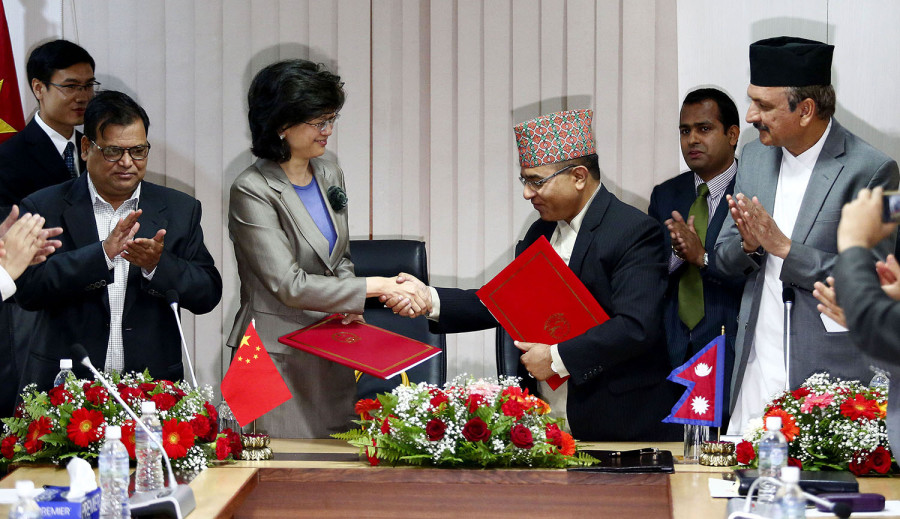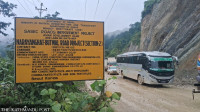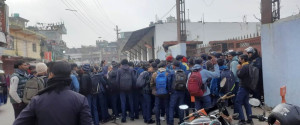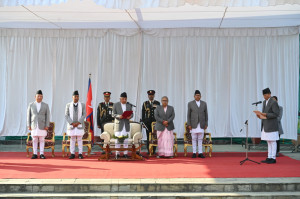National
With just 10 months left in BRI pact, not a single project has made any real progress
Besides a feasibility study for the Kerung-Kathmandu railway, none of the projects has reached the negotiation phase
Anil Giri
With just 10 months remaining in the framework agreement signed with China for the Belt and Road Initiative, Nepal has failed to make any headway on infrastructure project negotiations in the last 26 months.
Nepal had identified nine projects to finance under the BRI, but negotiations have come to a halt on all of them, according to officials at the Finance Ministry, which is the nodal agency to negotiate and execute projects under the BRI with various Chinese government agencies.
“Our line ministers do nothing,” said a Finance Ministry official, who spoke on condition of anonymity as he was not authorised to speak to the media. “They simply forward the name of the project and the salient features. It doesn’t come with a detailed project report or a financing modality. So we are not able to move forward with any project and hold negotiations with the Chinese.” The official is closely acquainted with the ministry’s dealings with the Chinese Embassy in Kathmandu and China’s Commerce Consular Office, which looks after Chinese funding in Nepal, including the BRI.
Nepal and China had signed a framework agreement on BRI on May 12, 2017 in Kathmandu, and as per the agreement paper, the pact will be valid up to May 12, 2020, subject to renewal if both parties so desire, according to Article 5.1 of the agreement paper.
Nepal had initially identified 35 projects related to infrastructure, energy, connectivity, trade, and commerce under the BRI and communicated to the Chinese during Prime Minister KP Sharma Oli’s visit to China in June. The Chinese side, however, advised Nepali officials to prioritise projects and trim the list to a single digit.
Nine projects were thus identified—upgrading the Rasuwagadhi-Kathmandu road; Kimathanka-Hile road construction; road construction from Dipayal to the Chinese southern border; the Tokha-Bidur road; the Galchhi-Rasuwagadhi-Kerung 400kv transmission line; the Kerung-Kathmandu rail; the 762MW Tamor hydroelectricity project; the 426MW Phukot Karnali hydroelectric project; and the Madan Bhandari Technical Institute.
So far, only the feasibility study of the Kerung-Kathmandu railway has been completed with Nepal and China to meet in Kathmandu in December to prepare a detailed project report of the long-awaited cross-border rail. The Kerung-Kathmandu railway was recently listed as part of the Second International Belt and Road Initiative in Beijing, under the Nepal-China Trans-Himalayan Multi-Dimensional Connectivity Network.
All other projects remain stalled, with negotiations yet to begin.
Officials, analysts and diplomats point to geopolitical concerns and a lack of proper homework regarding the nature and principle of the BRI for the lack of progress.
Foreign Minister Pradeep Gyawali pointed to numerous reasons behind the delay, including a lack of institutional wherewithal.
“When we signed the agreement with China, there was political instability and the government’s focus was on holding elections. Then we came in power and renewed our commitment and trimmed down number of projects from 35 to nine,” said Gyawali. “But our institutional capacity is weak. We do not even have cost estimates or detailed project reports. We just focus on preparing a wishlist without doing adequate homework.”
While Gyawali has allayed geopolitical concerns regarding increasing Chinese investment in Nepal, many international actors are more circumspect. Many in the international community have continually pushed the Nepal government to be wary of a “debt trap”, citing Chinese-funded projects in Asia and Africa. Foreign Minister Gyawali, however, has outright rejected the notion of a “debt trap”, calling it “imported psychology”.
Concerns over a debt trap were raised overtly by senior US State Department officials in May in Kathmandu, but there is also a section of the international community that has been quietly suggesting that the government maintain caution while dealing with projects under the BRI.
Apart from the US, some other western countries have also suggested that Nepal remains cautious while dealing with projects under the BRI, according to two officials familiar with communications from a few Kathmandu-based diplomats.
Since Nepal and China share a long border and history, Nepal should rely on China on various matters but having blanket dependency may cause disturbance, the diplomats are reported to have intimated.
In January, during the visit of Japanese Foreign Minister Taro Kano, the Japanese Foreign Ministry spokesperson told reporters that financial support from developed countries to developing countries like Nepal should be concessional and the process of such support should be transparent.
As if to allay any fears that Nepal might enter into a debt trap with China, Prime Minister KP Sharma Oli, at a recent Foreign Ministry programme, made clear that Nepal’s focus was now on attracting foreign direct investment, rather than seekings loans or grants.
“We are not interested in taking out loans,” Oli said.
But Pramod Jaiswal, a foreign policy analyst who has spent years in both China and India, told the Post that China doesn’t offer grant for BRI projects.
“First, Nepal has not prepared any projects for immediate funding because Nepal favours grants, which is not possible under the BRI framework,” said Jaiswal. “Second, Nepal did not agree to put money in large projects and also did not want to take risks like Pakistan did with the China-Pakistan Economic Corridor.”
Jaiswal also pointed to Nepal’s failure to ensure the feasibility of China-funded hydropower projects, like West Seti and Budhi Gandaki. Chinese don’t really want to invest here, he said.
But a major geopolitical concern is the construction of the Kerung-Kathmandu railway, said Jaiswal, as how ties between India and China evolve will determine how things play out between Kathmandu and Beijing.
“For the six or seven years it takes to begin construction of the Kerung-Kathmandu railway, India will remain positive about it, because gradually, India will be a part of the BRI, sooner or later,” said Jaiswal. “The ultimate benefit of the cross-border railway with China will go to India.”
Nepali diplomats, meanwhile, said that they’ve been working to execute projects under the BRI, without any obstruction at political or diplomatic levels. However, a lack of coordination among state agencies in Kathmandu are impeding progress, said one diplomat.
“We, the Nepali Embassy in Beijing, are regularly in touch with Kathmandu but projects under the BRI have hardly made any progress,” said Sushil Lamsal, deputy chief of mission at the Nepali Embassy in Beijing. “Though we are not directly involved in negotiations, as those are primarily handled by the Finance Ministry, we recently discussed expediting, executing, enhancing and uplifting projects under the BRI during a meeting between Foreign Minister Gyawali and his Chinese counterpart Wang Yi.”
As per the BRI framework agreement, both sides can change and add to the agreement as per their need and those amendments will be considered a part of the agreement papers. If one party wants to terminate the agreement papers before May 12, 2020, the concerned party should inform the other side three months in advance through diplomatic channels. If both parties do not terminate the pact prior to the expiry date, the framework agreement will be automatically renewed by another three years, as per the Article 5.3.
***
What do you think?
Dear reader, we’d like to hear from you. We regularly publish letters to the editor on contemporary issues or direct responses to something the Post has recently published. Please send your letters to [email protected] with "Letter to the Editor" in the subject line. Please include your name, location, and a contact address so one of our editors can reach out to you.




 5.05°C Kathmandu
5.05°C Kathmandu







%20(1).jpg&w=300&height=200)






